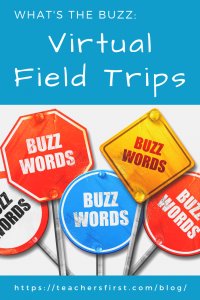 Let’s go on a field trip. Yes, right now. No buses, no permission slips, no money…no fooling. Yes, we can take our students on trips that will enhance our curriculum and give them valuable insight into topics we are learning about without the typical fuss. I’m talking about Virtual Field Trips, and they can be so exciting and engaging, your students will never want to come home.
Let’s go on a field trip. Yes, right now. No buses, no permission slips, no money…no fooling. Yes, we can take our students on trips that will enhance our curriculum and give them valuable insight into topics we are learning about without the typical fuss. I’m talking about Virtual Field Trips, and they can be so exciting and engaging, your students will never want to come home.
There are a lot of technology tools that can help you take your students on a virtual field trip. It is essential to find a tool that you are comfortable with so that you can help your students fully participate. Between websites with tours already made, Skype in the Classroom, Google Expeditions or even creating them yourself, you are sure to find a way to connect your classroom to a great experience.
Here are a few tips to making the best Virtual Field Trip experience for your students:
- Don’t undersell the importance. Part of the excitement of the field trip experience is the preparation and anticipation of the event. Don’t rob your students of this part of the trip just because you are not physically traveling somewhere. Make sure to build in the same type of activities as you would for regular field trips: make announcements, publish an itinerary, and complete companion activities before the trip.
- Preview the trip (if you can). It’s not always possible, especially if the trip is live via Skype or Google Hangouts, but if you can look at the trip ahead of time, that really helps. Look for items that explain content that students had difficulty with, that helps to give context to the topic, or that might make a nice entry as part of a field trip reflection. Test out any activity sheets and make sure that you know how to help students complete it.
- Keep students focused on learning. Virtual Field Trips are fun, but students need to remain accountable for what they should be learning during the trip. Have students keep a learning journal with them during the experience in which to keep their notes. This will help them to complete any reflection activity that you have prepared.
Interested in finding a Virtual Field Trip for your class? Start at one of these:
- EarthEcho Expeditions (reviewed here)
- The Anne Frank House Secret Annex
- Virtual Field Trip to Ellis Island (reviewed here)
- Mount Vernon Virtual Tour
- Discovery Education Virtual Field Trips (reviewed here)
- 4H Virtual Farm
- Statue of Liberty Virtual Tour (reviewed here)
- Global Trek
- The White House tour (reviewed here)
- Birthplaces of music
Do you have a favorite virtual field trip destination? Perhaps you have a tip to share with teachers that are just getting started using them in the classroom. Please share your wisdom and ideas in the comments below.


You have a great point about not underselling the importance. Teachers can help get students excited about a trip by the way they lead up to it. Thanks for the tips!
Teaching in the 21st-century has created a plethora of opportunities for educators and students alike to manximize on an enriching learning experience. I am always keen on exploring new instructional strategies and methodolgies that are not only fun and productive for student learning, but also cost effective and inclusive to meet the diverse learning needs of all students. Considering the socioeconomic status or mild to severe learning disabilities of many students, the virtual field trip experience, in my view, enhances teaching and learning so that all students are given equitable learning possibilies.
As an English teacher in Japan, I believe Virtual Field Trips would provide my Japanese ESL students broader knowledge and multicultural awareness about other cultures outside of their own territories. Also, “multicultural awareness provides teachers with greater understanding, sensititvity and appreciation of the history, values, lifestyles and experiences of others” (Aceves & Orosco, 2014). Though I am yet to implement a Virtual Field Trip in one of my ESL lessons, I am eager to experiment and see how the students react especially, with the use of the English language. This is will give them an authentic learning experience to be exposed to the language and in turn, try to utilize it meaningfully.
Thank you Dr. Okoye for the tips and the site recommendations. I wonder, do you have any suggestions for VFT on cultural experiences and countries? Please let me know.
References
Aceves, T.C., & Orosco, M.J. (2014). Culturally responsive teaching. Retrieved from https://ceedar.education.ufl.edu/tools/innovations-configurations
One idea that I have about virtual field trips is to place the names of the states / countries, etc. in a basket. Each week students will choose one to research. The class will collaborate and gather as much information as possible, Afterwards, students can post and share what they discovered using Padlet or Google Classroom. Afterwards, they can create a Question/ Answer project or other chosen activity or project to show their learning use during the course of discovering all 50 states / neighboring countries.